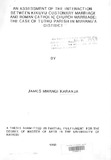An assessment of the interaction between kikuyu customary marriage and Roman Catholic Church marriage

View/
Date
1998Author
Karanja, James Mwangi
Type
ThesisLanguage
enMetadata
Show full item recordAbstract
Although the church has been growing numerically, the adherence to its teaching on
marriage is lacking and this is shown by the decline in the number of people who
marry in church today. Even those already married in church, it appears that they
find difficulty in channeling their marriages on church teachings on certain issues.
Notwithstanding, some marriages today have remained quite unstable even among
the faithfuls,
This study is about the interaction between Kikuyu customary marriage and Roman
Catholic Church marriage today. The study investigated whether there exists
conflict of values between the two forms of marriage by exploring how courtship,
bridewealth, wedding, polygamy, infertility, divorce among others are handled or
viewed by Kikuyu catholics today.
Tuthu Palish was selected because it had the earliest influence of Roman Catholic
church in Murang'a Diocese. Besides, funds availability, familiarity of the place and
the community by the author and the fact that the entire parishioners are Kikuyus
were other factors considered.
The thesis is as a result of both the secondary and primary data. The secondary
data was collected from major libraries in Nairobi as well as from Diocesan records.
The primary data was collected mainly through administration of questionnaires,
direct personal interviews as well as group discussions. Informants comprised the
aged, catechists, the youth and other informed parishioners.
The research findings showed that before the coming of catholic christian
missionaries in Kikuyu-land, there existed a stable marriage system. This stability was guaranteed by the kinship system, corrununity interest, bridewealth and practice
of polygamy among others. The research findings confirmed that the church played
a significant role in the disintegration of this maniage by condemning such
customary aspects as initiation lites, polygamy, widow inheritance and to some
extent bridewealrh payment. It also introduced the idea of indissolubility, individual
consent and equality of spouses in marriage.
The study also found out that some variables other than the church such as
urbanisation, money economy and modem education have also contributed to this
disintegration.
The study has highlighted that there is conflict of values among the adherents when
it comes to fmding solutions to some marital problems. The main areas the two
marriages differ include the place of relatives of spouses in church marriages, state
of childlessness and dissolubility of marriage. Other socio-economic factors were
found to have contributed to the dissatisfaction in marriages.
The study concludes that the church maniage has no! been very popular. It
suggests that some relatively harmless customary values such as involvement of
extended family and bridewealth payment could be incorporated into church
marnage. In tills way many Kikuyu catholics are likely 10 be attracted to church
marriage for it would appear relevant and meaningful to their lives.
Sponsorhip
University of NairobiPublisher
Department of Sociology, University of Nairobi
